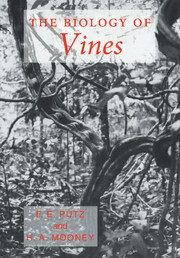Book contents
- Frontmatter
- Contents
- List of contributors
- Foreword
- Preface
- Acknowledgements
- I INTRODUCTION
- II CLIMBING MECHANICS AND STEM FORM
- 2 Anatomy of vine and liana stems: a review and synthesis
- 3 Biomechanical studies of vines
- 4 Structural responses to stem injury in vines
- III VINE PHYSIOLOGY AND DEVELOPMENT
- IV COMMUNITY ECOLOGY OF VINES
- V ECONOMIC IMPORTANCE OF VINES
- Taxonomic index
- General index
3 - Biomechanical studies of vines
Published online by Cambridge University Press: 05 November 2011
- Frontmatter
- Contents
- List of contributors
- Foreword
- Preface
- Acknowledgements
- I INTRODUCTION
- II CLIMBING MECHANICS AND STEM FORM
- 2 Anatomy of vine and liana stems: a review and synthesis
- 3 Biomechanical studies of vines
- 4 Structural responses to stem injury in vines
- III VINE PHYSIOLOGY AND DEVELOPMENT
- IV COMMUNITY ECOLOGY OF VINES
- V ECONOMIC IMPORTANCE OF VINES
- Taxonomic index
- General index
Summary
Although vines and self-supporting plants differ physiologically, anatomically, and phenologically, the primary differences are biomechanical. Lacking the capacity to hold themselves upright, climbing plants are constrained by their capacity to (i) encounter suitable structure(s) on which to climb; (ii) ascend efficiently; and, (iii) survive the inevitable mechanical demise of their supports. In this chapter, we address some of the biomechanical features of climbing plants within the context of their life history. We emphasize that vines have broken free from the constraints of having to be self-supporting, only to suffer new restrictions associated with mechanical dependence. Most of our comments pertain better to vines that climb by twining or with tendrils than to plants that climb with the aid of adventitious roots or other adhesive structures. Our bias towards woody vines (= lianas) in tropical forests (Figure 3.1) also will be apparent.
Locating suitable supports
Availability of suitable supports is a major constraint on the height growth of forest vines. The vast majority of vine ‘seedlings’ (and vines that have reached the top of their support) produce searcher shoots that grow up, bend over, and are successively replaced as each, in turn, fails to encounter a support (Palm, 1827; Darwin, 1867; Putz, 1984). In lowland forest in Panama, vines experimentally supplied with artificial trellises grew to be much taller than did control individuals (Putz, 1984). Vines can increase their likelihood of encountering a suitable support by: (i) actively searching; (ii) waiting (searching in time); and (iii) being able to ascend a wide range of support sizes.
- Type
- Chapter
- Information
- The Biology of Vines , pp. 73 - 98Publisher: Cambridge University PressPrint publication year: 1992
- 22
- Cited by



